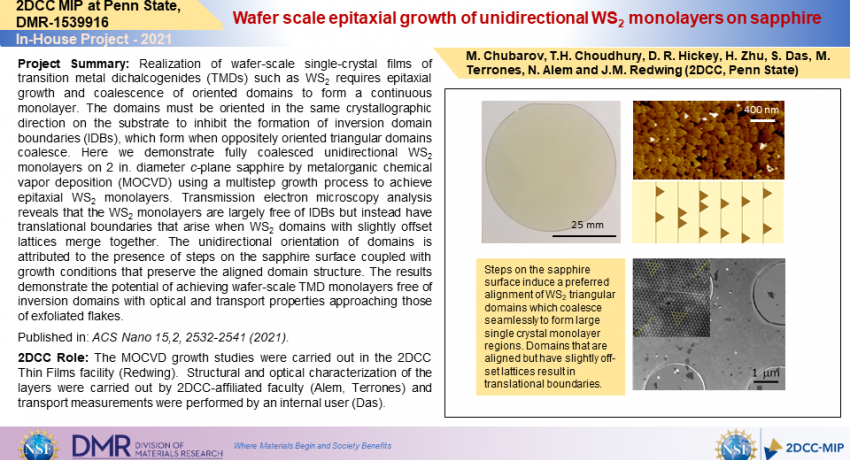What Has Been Achieved:
Epitaxial WS2 monolayers on 2” diameter sapphire that exhibit a unidirectional alignment of domains resulting in coalesced films that are largely free of inversion domain boundaries.
Importance of the Achievement:
A persistent problem in epitaxial growth of transition metal dichalcogenides has been the formation of inversion domain boundaries (also referred to as mirror twins) which arise when oppositely oriented TMD domains coalesce. The twin boundaries exhibit a metallic character which introduces conducting channels in the semiconducting monolayer. Inversion domains also are problematic for studying spin-valley polarization which relies on a uniform crystallographic direction. This work demonstrates that steps on the sapphire surface can induce a preferred alignment of domains resulting in coalesced WS2 monolayers that are largely free of inversion domain boundaries. Instead, the dominant defects are translational boundaries that arise when TMD domains that are off-set from one another by less than a unit cell coalesce. WS2 monolayers that are 95% single crystal (<5% of monolayer contains transitional boundaries) have been obtained.
Unique Feature(s) of the MIP that Enabled this Achievement:
2DCC-MIP’s MOCVD equipment that enables uniform growth on substrates up to 2” in diameter using high purity hydride precursors. Internal collaborations with 2DCC affiliated faculty and internal users with expertise in TEM, optical characterization and transport measurements.
Publication:
M. Chubarov, T.H. Choudhury, D. Reifsnyder Hickey, S. Bachu, T. Zhang, A. Sebastian, A. Bansal, H. Zhu, N. Trainor, S. Das, M.Terrones, N. Alem and J.M. Redwing, “Wafer scale epitaxial growth of unidirectional WS2 monolayers on sapphire,”, ACS Nano. 2021, 15,2 2532-2541. https://doi.org/10.1021/acsnano.0c06750.
Acknowledgments:
Primary financial support for this work was provided by the National Science Foundation (NSF) through the 2D Crystal Consortium–Materials Innovation Platform (2DCC-MIP) under NSF cooperative agreement DMR-1539916. D.R.H., S.B., and N.A. acknowledge additional support from an NSF CAREER grant (DMR-1654107). T.Z. and M.T. acknowledge the financial support of the Air Force Office of Scientific Research (AFOSR) through grant FA9550-18-1-0072. The work of S.D. and A.S. was partially supported by Army Research Office through Cooperative Agreement Grant W911NF1920338 and Air Force Office of Scientific Research (AFOSR) through the Young Investigator Program Grant FA9550-17-1-0018. This work utilized resources provided by the NSF-MRSEC-sponsored Materials Characterization Lab at Pennsylvania State University.
Credits/Names: M. Chubarov, T.H. Choudhury, D. R. Hickey, H. Zhu, S. Das, M. Terrones, N. Alem and J.M. Redwing (2DCC, Penn State)
Download PDF Version: 1539916_2DCCMIP_2021_WaferScaleEpitaxialGrowthOfUnidirectionalWS2MonolayersOnSapphire.pdf
Year of Research Highlight: 2021
Select a Highlight Type: In-House Research Highlight
